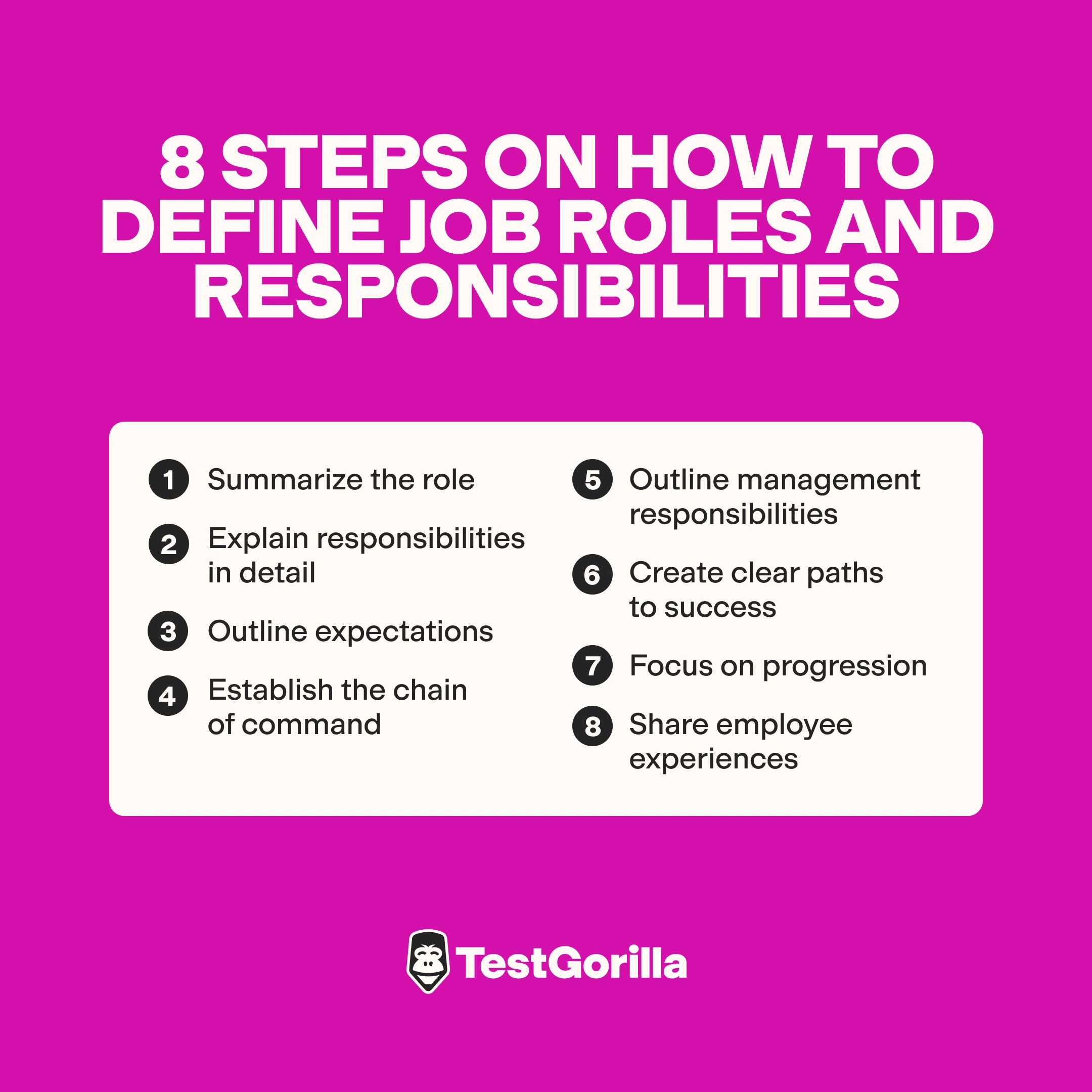Defining roles and responsibilities in the workplace: Why does it matter?
Ensure candidates can handle their roles and responsibilities
Without clearly documented roles and responsibilities, HR managers often struggle with a confused, inefficient, or unproductive workforce.
You can fall into this trap if you're:
Disconnected from the teams you hire for
Using an outdated roles and responsibilities template
Growing your business (and all hands are on deck)
Hiring without candidate skills testing
Accurately defining job roles and responsibilities better informs the decision-making process in your hiring, enhances team productivity, and inspires autonomy.
In this article, we explain what roles and responsibilities are in the workplace and why clarifying them for your team members is crucial. We also cover identifying and outlining roles and responsibilities in your organization.
Table of contents
- What are roles and responsibilities?
- What's the difference between roles and responsibilities?
- The importance of defining roles and responsibilities in the workplace
- Signs that your team needs more clarity on roles and responsibilities
- How to define job roles and responsibilities: 8 steps
- Our roles and responsibilities template
- Defining team roles and responsibilities leads to effective hiring
- Well-defined roles and responsibilities = Strong hiring practices
- Team roles and responsibilities FAQs
What are roles and responsibilities?
A role is a person's place or position within a team, such as a "Chief Marketing Officer." Responsibilities are the tasks and duties assigned to that role, such as "conducting market research" or "developing social media campaigns (organic and paid)."
When writing a great job description, hiring managers define the role at the top of the document, with the responsibilities of that role appearing underneath.
For our Chief Marketing Officer, a roles and responsibilities example outline might look like this:
Role: Chief Marketing Officer
Responsibilities:
Planning and developing marketing strategies
Conducting market, customer, and competitor research
Liaising with other departments on marketing strategies
Assisting with the implementation of marketing functions
What's the difference between roles and responsibilities?
A role identifies the position or part you play on a team, and responsibilities outline what you do in that position.
For example, an outbound sales agent's role is to qualify and warm up leads. One of their responsibilities is to secure revenue for the business.
Defining roles helps job candidates and employees identify their position in your company in relation to other team members, while responsibilities tell them what tasks they’re expected to complete. Having clear expectations in both of these categories ensures you assess candidates based on the skills they need to excel in their positions.
The importance of defining roles and responsibilities in the workplace
With a well-defined roles and responsibilities matrix, you can:
Attract better candidates: Candidates have a better idea of whether they’re right for a role and only apply if they’re confident they can do the job.
Improve candidate evaluation: When you know which responsibilities are critical to a role, you can filter candidates with skills-based tests. When hiring an accountant, you can test their ability to prepare financial statements, for example.
Prepare staff for success: Employees who understand what’s expected of them in their new roles work more effectively without guidance from project managers.
Boost team motivation and morale: Role ambiguity leads to stress, anxiety, burnout, and low performance. Role clarity boosts morale and motivation by informing employees how their work is assessed.
Improve team productivity: Research from Effectory shows that improved individual role and responsibility definitions enhance employee output by 25%. In addition, 83% of employees with clear roles also report high productivity.
Improve collaboration and cohesion: A roles and responsibilities matrix helps departments understand the part each person plays in the final product. This leads to greater collaboration and strategic alignment.
In a skills-based hiring strategy, clearly defined roles and responsibilities also help define how you should test and evaluate candidates. For instance, if you determine SEO skills are crucial for your content marketing specialist, you can test their knowledge with a talent assessment.
Signs that your team needs more clarity on roles and responsibilities
There are a few ways to spot if your team needs more role clarity.
Remember, you don't always receive direct employee feedback, and you can't always blame poor documentation on a lack of HR competencies.
Here are a few indicators to look out for:
Employee burnout: Flimsy, inaccurate, or underwhelming role clarity drives long-term sickness caused by confusion and stress, a lack of respect for others, and negative attitudes.
Lack of collaboration: Confusion around roles and responsibilities harms communication and creates gaps between teams. Staff can't see the impact of their work on the wider business, and productivity suffers.
Increased human error: With larger teams, work gets sloppy when members don't collaborate or communicate effectively – often due to a lack of explicit responsibilities.
Productivity issues: If you don't define clear roles and responsibilities, your entire team could waste time redoing the same work. It's a widespread problem: In the US, a single employee wastes almost five hours a week because of duplication.
Talent turnover: Unclear roles and responsibilities frustrate workers. They feel ignored and lost, as though they are not a proper part of the team. This leads to disengagement and, eventually, quitting.
Lower probation period pass rates: Comprehensive role definitions and documentation help new hires understand their positions in a company more efficiently and help them pass probation periods.
Missing documentation: Employees without well-defined guidelines might feel stranded. Create easy-to-read SOPs, digital guides, and workflows.
How to define job roles and responsibilities: 8 steps
Before we share our roles and responsibilities template, let’s look at how you can define the roles and responsibilities within your organization.
To ensure strategic alignment among managers, supervisors, and employees, it’s a good idea to share this information via a hub or a portal accessible through your intranet.
Step | How? |
1. Summarize the role | Define the role with a job title and a summary of the position within the company |
2. Explain responsibilities in detail | Detail the necessary tasks required of employees within the role, the tools they use, and who they answer to |
3. Outline expectations | Outline clear expectations by defining clear skills required for the role and how the employee will be evaluated |
4. Establish the chain of command | Be transparent about who team members report to, when, and which checkpoints are required |
5. Outline management responsibilities | Clarify if anyone is answerable to the employee and to what extent |
6. Create clear paths to success | Outline what success looks like in this role, with examples, and how the employee can achieve the right outcomes |
7. Focus on progression | Explain the benefits of excelling in this role, detailing opportunities for development, progression, or promotion |
8. Share employee experiences | Share clear case studies that help employees visualize what success looks like in your role |
1. Summarize the role(s)
Step 1 is an overall assessment of the particular role. What does the employee in this position do? What's their job title, and how do they fit into the work environment?
You should clearly understand what each role means in your company because this helps you accurately define its responsibilities and facilitates many of the subsequent steps.
If you're unsure, conduct a job tasks analysis to gain closer insight into each role's responsibilities in your organization. This type of analysis helps your hiring team understand each role and its position within the business hierarchy.
When defining a person’s role versus responsibilities within your job postings, aim to be concise. A clear and concise role description leaves little room for doubt and confusion.
2. Explain responsibilities in detail
Once you have your role outlined, define the responsibilities connected to it. Defining responsibility requirements in a role helps applicants envision their place in your business.
In fact, according to LinkedIn research, at least 70% of candidates prioritize details about roles and responsibilities over all other information you give at the interview stage.
To define responsibilities, determine what you want your employee to achieve in their roles and which tasks they need to manage to achieve the right results.
If the goal of hiring a social media manager is to improve brand awareness and drive customers back to your website, responsibilities might include:
Creating and managing a social media calendar
Responding to social media comments and discussions
Checking online for company mentions and customer feedback
Evaluating campaign results with a focus on metrics like click-through rate
When fleshing out responsibilities in your intranet portal, link to specific guides, SOPs, and walkthroughs so that employees have detailed sources to reference.
3. Outline expectations
Outlining expectations means showing candidates how you evaluate their skills and performance. For instance, if you’re hiring a copywriter, one of their responsibilities may be creating search-engine-optimized content.
This means you would expect those professionals to have SEO copywriting skills. You might also want them to have Google SEO certifications or knowledge of backlinking processes, but these requirements may not be as essential.
It’s worth splitting expectations into required and desired outcomes to give candidates extra clarity. For an SEO copywriter, the required outcome may be to improve positioning on search engine results pages, while the desired outcome could be attracting reputable backlinks.
Outlining clear expectations helps you attract the candidates you want to attract. It can also help you define the key skills-based hiring tests to use when evaluating a candidate’s abilities before hiring commences.
4. Establish the chain of command
Every employee's role outline should tell them who they report to. An easily understandable chain of command leads to better communication and teamwork.
A chain of command doesn't purely list managers and supervisors – it also includes other stakeholders (i.e., subject matter experts) involved in day-to-day projects.
For example, a graphic designer could report to a marketing manager, a copy editor, and their own supervisors. This chain should explain what management expects from their workforce through these communication channels. Who do they present drafts to? Who should they email if they need support?
Transparent chains of command help departments build mutual respect through collaboration and reduce the risk of duplicated work.
5. Outline management responsibilities
Just as you outline who workers answer to, consider the reverse – who's answerable to them? Do they communicate with multiple departments or several employees within a single team?
Create a roles and responsibilities chart explaining how the hierarchy works in your organization. Be clear on the reviews managers and team leaders conduct to keep projects on track and assess the team’s goals.
Build company-wide coaching checklists and edit them with regular feedback from your managers.
Top tip: Don't assume qualified managers don't need any guidance. This attitude risks communication overlap, inappropriate or irrelevant feedback delivery, and frustrated personnel.
6. Create clear paths to success
You often gather inspiration and guidance from existing employees when defining team member roles and responsibilities. If you have any shining examples of high performance in a role, share them with new employees.
For instance, maybe an accountant helped reduce operational costs by 25% by introducing a new cash flow forecasting strategy and was recently promoted to “senior management accountant.”
By sharing success, you give your hires a better picture of how your company works and what you expect from them.
"Showing, not telling" helps people to visualize how individual and project team success is possible. This removes ambiguity and the need for clarification when hiring and on the job.
7. Focus on progression
Beyond salary and financial incentives, your hires want to build new skills and grow with you.
Testing employee skills post-hiring helps you find new opportunities for employee development. Even if progression opportunities aren't available in specific roles, you can show them potential incentives for great work.
Use talent assessments to assess your employees’ skill sets
If an employee shows aptitude and loyalty, could they progress to a supervisory role within the next three years? If your team members excel in their current responsibilities, will you help them take on new challenges with learning and development opportunities?
Show where these new skills could lead employees in your organization, and use this strategy to attract talented people looking for professional growth and increase your talent retention rates.
8. Share employee experiences
Make your job openings more tempting with detailed examples of what happens on a typical day on the team. Gather insights into what life in your company is like with employee surveys, and ask employees to share their stories.
Sharing experiences isn't purely promotional. Letting employees share their stories helps candidates:
Understand whether or not they're the right fit for the job
Appreciate what management expects of them from day to day
Evaluate the company culture
This new dimension of clarity enables you to find candidates with relevant experience and the right personality for your culture.
Our roles and responsibilities template
We’ve created a roles and responsibilities template for you to use as a starting point.
Use this to start creating more powerful job descriptions and hire top talent.
Role title
[Company name]
Example role title:
Job Title: [E.g., Chief Marketing Officer]
Reports to: [E.g., Marketing Director]
Location: [Onsite, remote, or hybrid]
Role summary
Briefly explain the role and its impact on the business.
Example role summary:
Our chief marketing officer plans, develops, implements, and monitors the overall business marketing strategy, guiding and directing the marketing team. They also lead all marketing team meetings.
Responsibilities
List the key responsibilities relevant to the role, outline the tools hires will use, and cover daily tasks. Remember to be highly detailed with your list of responsibilities, but avoid redundancies.
Example responsibilities:
Conduct keyword research: Use analytical tools such as SEMRush to identify high-quality keywords for content marketing campaigns and share them with the marketing team.
Conduct market research: Use trend analysis and market data to identify new opportunities for marketing campaigns.
Expectations
Outline what’s expected from employees, which essential and desirable skills they need, and how you assess their work's outcomes.
Example expectations:
[Role name] uses [software] for daily marketing campaign analysis
[Role name] reports campaign metrics weekly to [supervisor]
[Supervisor] evaluates [role name’s] performance based on [metrics]
A successful [role name] demonstrates value by [include an example of success achieved by employees with similar roles and responsibilities].
Chain of command and management responsibilities
Disclose who new hires report to and who reports to them.
Example chain of command:
[Role name] reports to [supervisor titles] and submits regular reports on their performance based on [key metrics]
[Role name] manages [employee roles] and reports on [metrics, or KPIs]
Progression opportunities
Discuss the benefits of excelling in this role.
Example progression opportunity:
A successful [role name] will gain access to [development opportunities, training, responsibilities, promotion opportunities, etc.] after [x months] of delivering clear results.
Defining team roles and responsibilities leads to effective hiring
Clearly identifying roles and responsibilities doesn't just give clarity to candidates and employees; it also ensures you know precisely what you're looking for in a new hire.
This enables a skills-based approach to the hiring process, in which a person's abilities are prioritized rather than their degrees.
TestGorilla offers 400+ specialist tests that can assess a candidate’s ability to succeed in a specific role.
For example, if you're hiring a social media manager for a fashion company, you could test your candidate's Instagram marketing skills, evaluating their knowledge of accounts and features, content strategy development, and community management.
If hiring a graphic designer, you could test each candidate's proficiency with specific tools,like Blender, or evaluate their knowledge of UX/UI design.
You can even examine candidates' soft skills related to their core responsibilities. For instance, a Sales Rep's core responsibilities often include:
Building relationships with customers (evaluated with a communication test)
Managing customer accounts (assessed with an account management test)
Negotiating during deals (evaluated with a negotiation skills test)
Tests for all of the above can be found within our test library.
With TestGorilla's free plan, you can even create a continuous testing plan for your employees to ensure they can handle new responsibilities as their roles evolve.
Accurately assess for roles and responsibilities with talent assessments
A great example is Nexus HR using TestGorilla to evaluate candidates' critical skills and cognitive abilities when expanding their team. This helped the team screen higher volumes of applicants accurately and substantially improve hire quality.
Well-defined roles and responsibilities = Strong hiring practices
As a human resources manager, solid role identities enable you to hire based on skills, not just experience.
With well-defined responsibilities, your team is happier, more confident, more productive, and ready to grow with your business.
If you'd like to learn more about how skills testing helps improve your corporate culture, we've got a guide to help you navigate your way through pre-employment testing.
Next, sign up for your free-forever account or book a free 30-minute live demo to get started with our talent assessment software today.
Team roles and responsibilities FAQs
Do you still have questions about roles and responsibilities? Find your answers below.
What are examples of roles and responsibilities?
An example of a role is "Sales Manager: Oversees and manages the entire sales team." Responsibilities linked to this role could include developing sales strategies, forecasting sales targets, training and coaching representatives, and monitoring team performance.
What are the responsibilities in job roles?
Job responsibilities refer to the specific tasks and duties connected to a role. Roles outline a person's position on a team, while responsibilities emphasize what will be expected of that employee, which tools and processes they use, and who they answer to.
Why define roles and responsibilities?
Clearly identifying roles and responsibilities helps employees understand their position in the business and the team’s mission. Clarity in roles and responsibilities also helps hiring managers identify the skills they need to assess candidates when choosing the right person to employ.
Related posts
Hire the best candidates with TestGorilla
Create pre-employment assessments in minutes to screen candidates, save time, and hire the best talent.
Latest posts
The best advice in pre-employment testing, in your inbox.
No spam. Unsubscribe at any time.

Hire the best. No bias. No stress.
Our screening tests identify the best candidates and make your hiring decisions faster, easier, and bias-free.
Free resources
This checklist covers key features you should look for when choosing a skills testing platform
This resource will help you develop an onboarding checklist for new hires.
How to assess your candidates' attention to detail.
Learn how to get human resources certified through HRCI or SHRM.
Learn how you can improve the level of talent at your company.
Learn how CapitalT reduced hiring bias with online skills assessments.
Learn how to make the resume process more efficient and more effective.
Improve your hiring strategy with these 7 critical recruitment metrics.
Learn how Sukhi decreased time spent reviewing resumes by 83%!
Hire more efficiently with these hacks that 99% of recruiters aren't using.
Make a business case for diversity and inclusion initiatives with this data.























